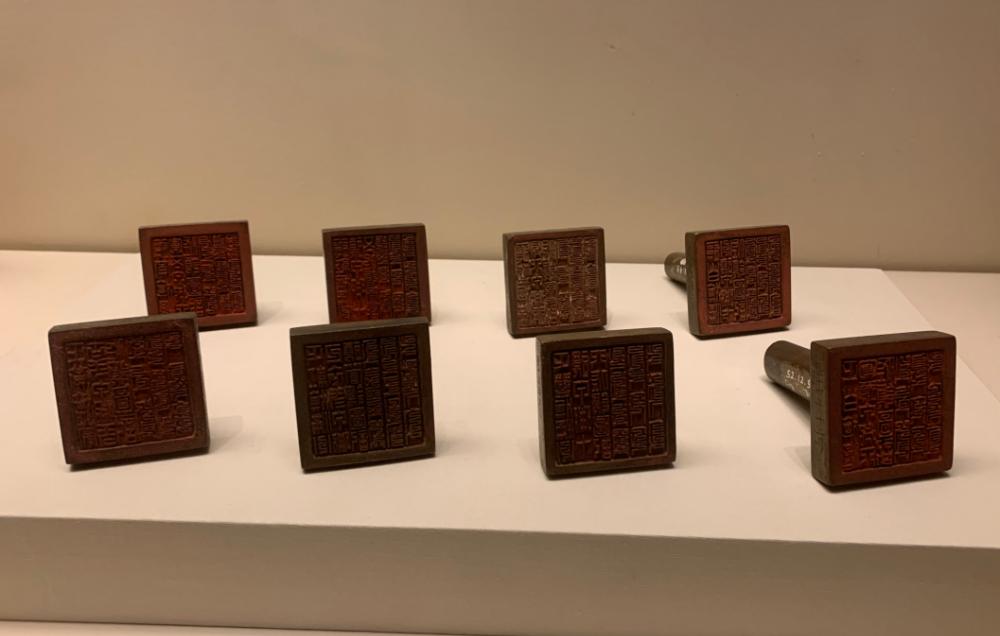The seals of the Manchu military and social organizations in the Qing Dynasty were made of copper, and the style and size varied according to the size of the grade.
In the twenty-ninth year of the Ming Dynasty (1601 AD), Nurhaci set up four banners of yellow, white, red and blue. In the forty-third year of the Wanli Calendar (1615 AD), the four flags of yellow, white, red and blue were added, collectively known as the Eight Banners, which are the Eight Banners of Manchuria. There are also eight banners of Mongolia and eight banners of Han army.
After the Qing army entered the customs, because Dolgun was convicted, the zhengbai banner was collected by the emperor himself, with the yellow flag, the yellow flag, and the white flag as the upper three banners, and the remaining five banners as the lower five banners, so as to distinguish the differences in household registration, official system, military system, etc., and implement a three-level management system of the collar, the staff leader, and the flag. Manchurian, Mongol, Han, and wrapping ranks are orderly and must not be impersonated.
Zuo Ling was a grassroots official of the Eight Banners Organization. He is in charge of the household registration, farmhouse, military registration, litigation, etc. In order to manage 300 people, there are two kinds of hereditary and non-hereditary officials. The seal letters used by officials such as the Eight Banners and the Provincial Co-leaders are called Tuji.

Road snow photography
During the Qing Dynasty And Emperor Taizong period, the Eight Banners Organization developed rapidly. Before entering the customs, there were a total of 309 collars in the Eight Banners of Manchuria, and 18 were divided into half collars; 117 Mongol collars and 5 were divided into half collars; and 157 were han army collars and 5 were divided into 5 collars. There are a total of 583 eight banners, Mongolian and Han Zuo collars, and 28 half of them are divided.
At the beginning of the Qing dynasty's rule over the whole country, due to the needs of the war to unify the whole country and to pacify the anti-Qing struggle in various places, the Eight Banners of Manchuria developed rapidly. During the Shunzhi Dynasty, the Eight Banners of Beijing added 8 Manchurian Zuoling, Mongolian Zuoling 8, and Han Junzuo 47. During the Kangxi Dynasty, the number of Manchurian zuoling reached 669, and during the Jiaqing period, it increased to 681. This level has since been maintained. The Mongol Zuo ling increased by 11 during the Shunzhi period, added another 76 during the Kangxi dynasty, and customized 204 in the second year of Yongzheng (1724).
When the Eight Banners system was established, there were Mongols organized in the Eight Banners of Manchuria, and until the end of the Qing Dynasty, there were 35 Mongolian zodiacs, and 2 were half divided into two collars, which were organized under the Eight Banners of Manchuria. In the fifteenth year of Shunzhi, there were 206 Han army leaders, and another half of them had 3 collars. In the fifty-first year of the Kangxi Dynasty (1712), it increased to 258, and another half of them were divided into 1. Yongzheng twelve years customized for 270 pieces. Since then, due to the increasing difficulties in the livelihood of the Eight Banners, some of the Han army has issued flags for the people.
In the fifty-fifth year of Qianlong (1790), the number of Han army commanders was reduced to 266. Since then, it has not changed. The number of officers and men in the Eight Banners, at the end of the Qing Dynasty, guangxu, Xuanun, there were about 6680 actual officials, a total of 817 auxiliary leaders stationed in the country, and the strength of the army reached about 120,000.
The drawings in the above picture are written in bronze and are now in the National Museum of China. Height 9.2 cm to 9.4 cm, side length 5.2 cm to 5.7 cm, stylistic and size depending on the level of the main printer grade slightly different.
Editor-in-charge: Jia Tingyi